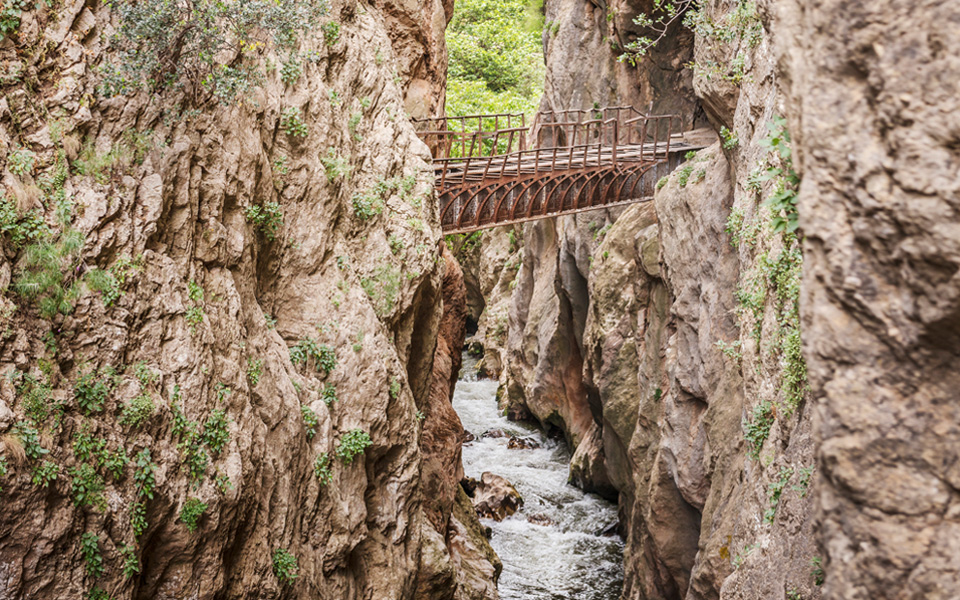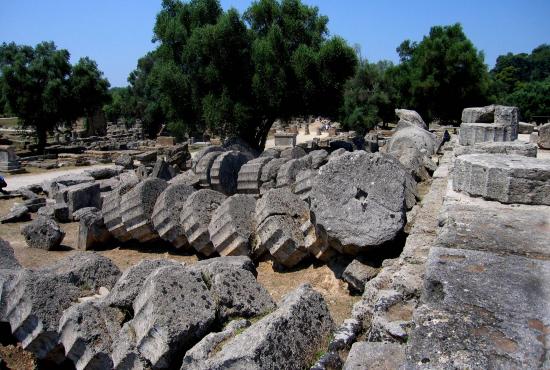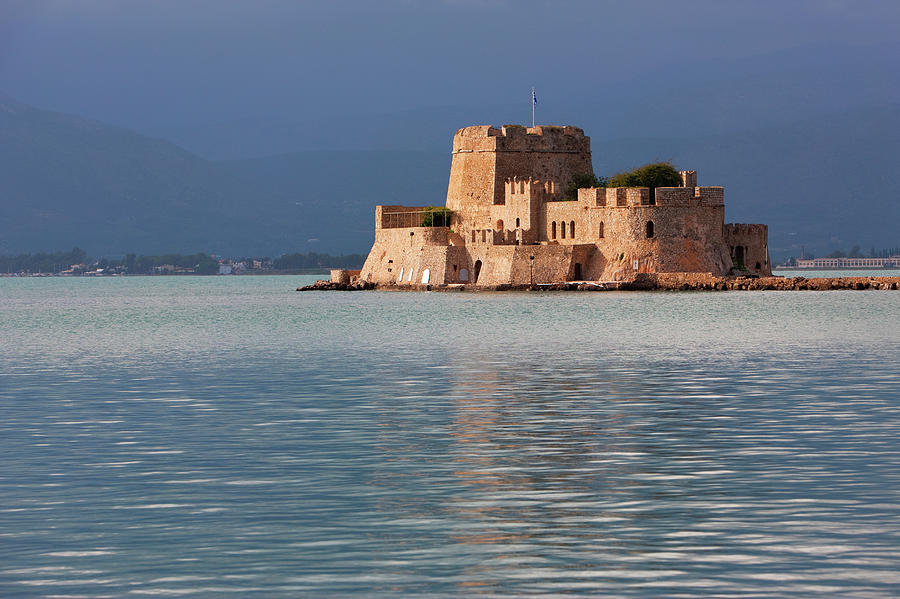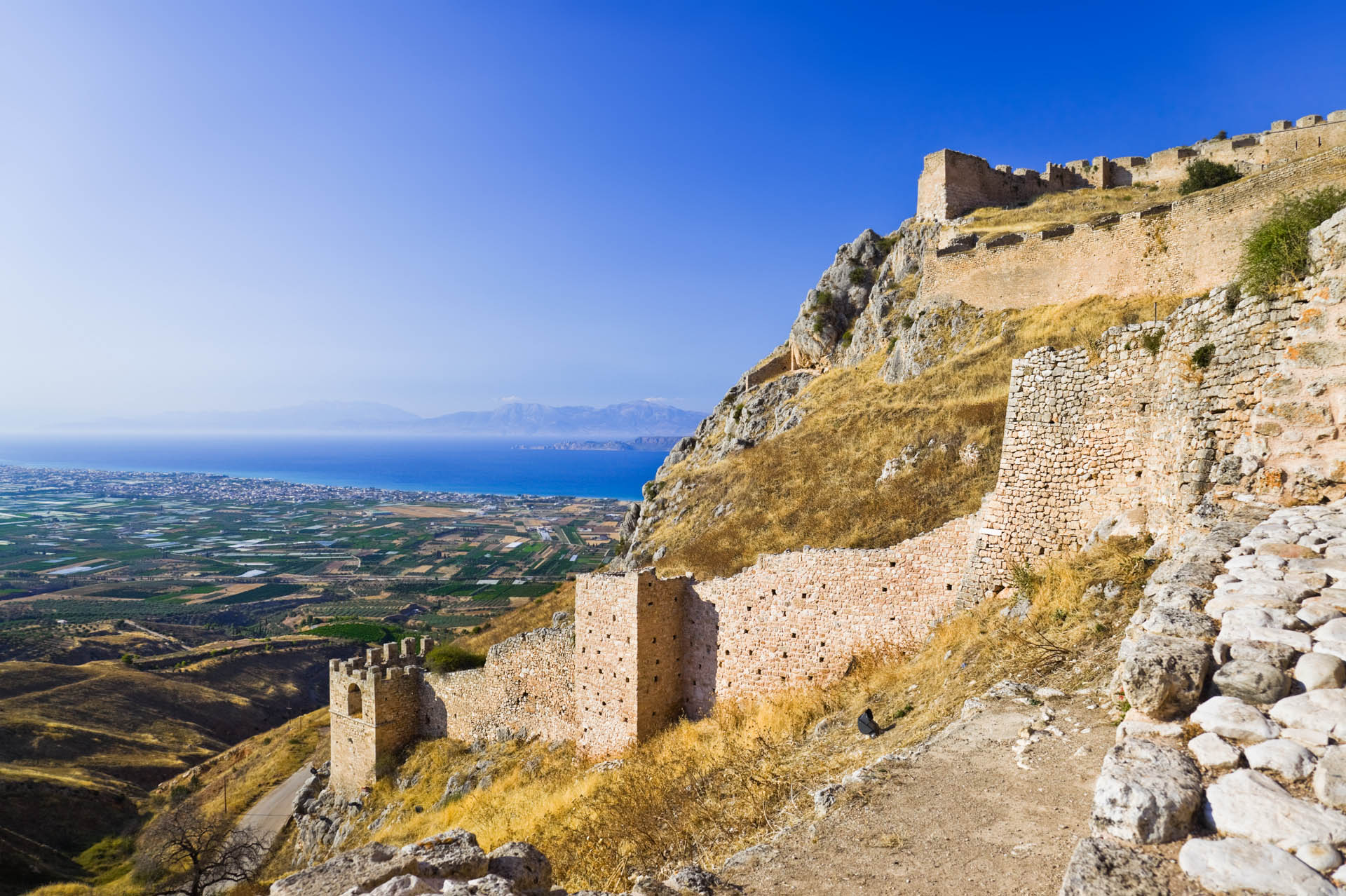Peloponnese (Nafplio, Kalamata, Patras) April 2-4, 2019
Rio-Antirrio Bridge (officially Charilaos Trikoupis Bridge). At 2,880m, this monster is one of the world’s longest multi-span cable-stayed bridges and the longest of the fully suspended type (the continuous, fully suspended deck is 2,252m long). It crosses the Gulf of Corinth near Patras, linking the town of Rio on the Peloponnese peninsula to Antirro on mainland Greece by road. The 90m-diameter foundation lays on a seabed 65m deep. It is very attractive with its four massive towers and cable spans.
Walking the bridge is free with protected pedestrian sidewalks on each side.
With a whopping toll of €13.50, I drove across at 30kms/hour to savour the experience.
PATRAS (pop 214,000)
Patras is Greece’s 3rd largest city and the capital of Western Greece. 215 km east of Athens, it is built on the foothills of Mount Panachaikon overlooking the Gulf of Patras. The busy port is connected with Italy and the rest of Western Europe.
History. Stretching 4 millennia, it was the cosmopolitan centre of the Eastern Mediterranean in Roman times. It was also the site of the martyrdom of St Andrew.
It has two public universities with excellence in technological education. In February, it hosts one of Europe’s biggest carnivals with mammoth satirical floats, balls and parades.
Archaeological Museum of Patras. Housed in a spectacular 8000 sq. m building built in 2009, it has a 500 sq. m pool and a shiny metallic dome. It has the usual history of Patras from prehistory to the end of Roman times. The highlight is the reconstructed Roman residence and 14 Roman mosaics, most mounted vertically. €8
St Andrew’s Cathedral. This is a lovely church. The façade has several copper domes, one large central dome and 6 smaller towers. There are several nice features: intricately carved wood doors, chairs and altars, silver and gold icons at the entrance, completely frescoed walls and ceiling, mosaics on the arches and a nice silver reliquary of St Andrew (plus bits of the cross he was martyred on. Unusually the floor has lush patterned carpets. Free
Patras Lighthouse. This lovely round-stone lighthouse has been integrated into a very attractive restaurant – all-glass walls and ceiling with wonderful views to the west across the water.
My original plan was to head south to Olympia until I read about this railway, so made the big one-hour detour west. This day ended up being a huge driving day, cut significantly shorter by the detour to the railway. It was 2½ hours to Olympia and another 1+ hours to the Temple of Apollo. But I saw two World Heritage Sites and a wonderful canyon.
Diakofto-Kalavryta Rack Railway. One of the unmissable journeys to make in the Peloponnese is aboard the tiny, unique train running along the railway from Diakofto to Kalavryta. It takes travellers on an unforgettable ride through the dramatic Vouraïkos Gorge climbing over 700m in 22.5km, using a rack-and-pinion (cog) system for traction on the steep sections, effectively clamping itself to the notched girder you can see running between the rails. Built by an Italian company between 1885 and 1895, the railway was a remarkable feat of engineering for its time, with only a handful of equivalents around the world (most notably in the Swiss Alps). Between 2007 and 2009 the trains were off the tracks as the entire rails and cog sections were completely replaced, and four new modern trains were constructed to replace the former carriages. The original steam engines that first plied the route were replaced in the early 1960s by diesel cars, but the old engines can still be seen.
As you head through the gorge, the line switches back and forth under a leafy canopy of plane trees and clings to a narrow ledge overhanging the river, passing through seven curving tunnels along the way. The journey takes just over an hour, stopping en route at Zahlorou. The first train leaves at 09:05. €9.50 one-way, €19 return.


I asked someone in Patras the time (it had changed to daylight savings time the day before), changed my watch and left Patras at 7 to catch the train that left at 09:05. I arrived 2 minutes before departure!! This was a significant detour from my route – 55 km east of Patras.
The scenery starts immediately with eroded, vertical sandstone cliffs (many conglomerates and desert varnish) on both sides and the rushing river below. Except for the olive trees and wild flowering cherries, it reminded me very much of the Colorado Plateau. The river cuts an amazing gorge in places. With empty seats on both sides, I was able to get the best views all the way. The trees were just coming into leaf. It was lovely. The track is only about 2 feet wide with a central “grab” rail on the steep sections.
Several got off halfway at Zahlorou to hike back down. The canyon changed significantly after this, opening up considerably. Tiny villages and wind turbines on the hills appeared. The rest of the passengers in the car were a group of 8 older Greek men who were walking back down from Kalavryta (6 hours). They all spoke good English and I talked to one of them who was 81. A French couple from Paris were having lunch and then returning. Kalavryta is a small town in a wide-open valley with small fields. Snow-covered mountains were to the south. Trees were just beginning to leaf out here and several had a small white blossom. The train stopped for 10 minutes and went back down.
In return, there was a huge crowd of over 100 for the next train at 10:30. The drive to Olympia was over 2 hours from the railway back through Patras, down the coast and then overland.
OLYMPIA
Archaeological Site of Olympia. The Olympics were undoubtedly the Ancient World’s biggest sporting event. During the games, warring states briefly halted their squabbles, corporate sponsors vied to outdo each other, and victorious competitors won great fame and considerable fortune. You could say much the same about the modern-day equivalent, the main difference being that back then only men could compete and they did most of it sans underpants.
On the slopes of Kronos Hill at the confluence of the Alpheas and Kladies River, the sanctuary to Zeus began in the 9th century BC, the first buildings in the 7th to 6th century BC and the complex reached its peak in the Classical Period in the 5th to 4th century BC. The gold/ivory cult statue to Zeus was one of the ancient wonders of the world (but no longer exists). The Romans conquered Greece almost peaceably in 146 BC and treated Olympia with great respect adding many significant buildings mostly for the athlete’s use.
Starting in 776 BC, the games were held every four years until their abolition by killjoy Emperor Theodosius I in AD 394, lasting almost 1000 years. Many of the buildings had been pulled down to use as building material for defences when the Romans were attacked by the Herulians in 267 AD. The complex was ordered to be destroyed by imperial decree in 434 AD and earthquakes in 522 and 551 AD completed the job. The site was covered over by flooding of the two rivers and forgotten about until excavation started by the Germans in 1875.
The World Heritage-listed site of Ancient Olympia (1986) is still a recognizable complex of temples, priests’ dwellings and public buildings, although almost all of it is short ruined walls with a few standing columns. The site contains excellent explanatory boards, with depictions of what the buildings would have looked like, along with a plan and description in English.
Some of the interesting places are: The Nymphaion was a great fountain backed by a double tier of statues, most in the museum. The Bases of Zanes (plural of Zeus) were bronze statues of Zeus on 16 bases, paid for by fines levied on athletes found cheating. The stadium was 192m x 28m, had no seats and held 45,000 spectators on its sloping banks. The most complete “building” with most of its columns still standing is the Palaestra, where the athletes undressed, oiled and dusted themselves with powder and trained. Since 1936, the modern Olympic flame is still lit at Hera’s Altar today before starting its trip to the Olympics.

The complex was declared a World Heritage Site in 1986.
Archaeological Museum of Olympia. This superb museum – Ancient Olympia’s archaeological site museum – about 200m north of the sanctuary’s ticket kiosk, is a great place to start or end your visit to the site of Ancient Olympia.
The museum includes a scale model of the site, many statues, some great glass and bronzes, and reassembled pediments and metopes from the Temple of Zeus. The eastern pediment depicts the chariot race between Pelops and Oinomaos, the western pediment shows the fight between the Centaurs and Lapiths, and the metopes depict the Twelve Labours of Hercules.
Combined ticket €12. It also included the Museum of the History of the Olympic Games which I couldn’t find.
It was then a long one-hour drive on windy roads through hilltop villages to the top of the mountains and this temple.
Temple of Apollo Epicurius at Bassae (“Parthenon of Pelop). This amazing temple declared a World Heritage Site in 1986, sits on the very top of the mountains at 1131m elevation. The temple was built by the citizens of Phigleia in 420-400 BC as a sanctuary to honour Apollo after surviving attacks from the Spartans (Epikourios was the assistant god of war). It is an amazing Doric temple with 6 columns by 15 columns and a Doric frieze. An Ionic frieze (in the British Museum since 18i5) was 31m long and composed of 23 marble slabs, 12 commemorating the battle with the Greeks and 11, the battle with the Lepiths. Inside the columns is a great rectangular temple building. The temple was destroyed by the Byzantines and required massive restoration works. An anti-seismic scaffold was constructed and a tent erected over the entire temple in 1987.
The large field below is littered with stone from the original temple – one can only imagine how massive it was.
Archaeological Site of Ancient Messene.
Between the 8th and 5th centuries, four major wars were fought between the Messenians and Sparta. They were finally defeated in the last (464-460 BC) and eventually were expelled completely from the town settling on the north coast of Africa. Colonists from Thebes founded the independent kingdom of Messene in 369 BC and it flourished until the 1st century AD, then slowly declined and was abandoned in 360 AD. The area was subsequently resettled by Christians and then Byzantines.
A tentative WHS (16/01/2014) in the south of the Pelopponese, this was another tortuous drive over a few high passes and through several tiny villages. Enter the complex about a kilometre north at the Arcadian Gate, an arch with two guard towers made of huge stone blocks that protected the road between the town of Messene and Arcadia.

Five grave chambers on both sides of the road contained marble sarcophagi. This may be the highlight of the entire complex.
If you do endure the roads, save your money and drive to the town above and look down at the ruins. You get a much better view of the layout and there is little to see other than crumbling walls, a fountain, some columns and a restored theatre and stadium. Even the museum is a waste of time. €12, €6 reduced
Kalamata. A NM “European City”, this was on what appeared to be a natural route to Messene. But that direct road went up and over big snow-covered mountains and even though it was only 30kms as the crow flies, it was over 100 tortuous kilometres. The much longer drive around the north end of the mountains ended up being shorter. Google Maps does not show elevation change.
I looked for something of interest to see in this town but even had difficulty accessing the water. I supposed that having an olive named after it was the reason for its inclusion. The 30km detour each way was a waste of time and added significantly to a long drive day.
Archaeological Site of Mystras. Built near the old ruins of Sparta, this was, from 1262, the secular headquarters of the Byzantine Empire in the Pelopponese until 1460 when the Ottomans successfully laid conquest to it. It was named a World Heritage Site as it is one of the best examples of a medieval late-Byzantine site and its relationship to Europe.
Sitting on the side of an almost vertical mountain, it offered security, freshwater from a spring, fertile land below and both a quarry and forest for building material. The steep streets prevented use of anything wheeled. I entered at the bottom and walked up past the museum (not worth going to), the church (locked), the monastery (with nice but faded frescoes and great architecture) and all the way up to the palace (the administrative headquarters) that was closed for renovations (this really pissed me off).

It appeared that the best way to see the place would be to drive to the large fort on the top of the mountain and walk down. I’m not sure how you could shuttle back to your vehicle. I was warned that it was foolish to wear shorts and flip-flops by one of the staff because of snakes!! €12, €6 reduced.
NAFPLIO
Nafplio is a seaside resort town that must be very busy in the summer. It has a nice pedestrianized downtown and a big square surrounded by restaurants. I parked in the huge parking lot at the west end of the harbor and was kicked out as it was for buses only (it could easily hold 50) even though it was completely empty. I got to watch the sunset.
Tiryns is about 5kms north of the city. I didn’t go as I was going to nearby Mycenae the next day. It appeared to be only a long wall of huge stone blocks.
Archaeological Museum of Nafplio. Occupying a grand stone building on the west end of the main square, gives a history of Greek, Roman and Byzantine occupation with the usual mundane exhibits. €6, €3 reduced
Peloponnesian Folklore Foundation. Has the usual farm implements, household items and clothing, all relatively high-fashion women’s. €5, €3 reduced
War Museum. Occupying two floors, this is a poor museum with many photos, pictures from visual books, guns, swords and uniforms. Some labels are in English but the amount of information gleaned about Nafplio and Greece and war is almost zero. Watching the video (subtitled) tells about the Italian and German invasions in WWII and gives a biased viewpoint of Greek bravery as they surrendered without a fight. Starvation was rampant. €3, €1.50 reduced
Bourtzi. This is on the tiny island of St Theodoroi in the middle of the harbour of Nafplio. Castello dello Soglio was the first name of the Venetian castle built in 1473. Bourtzi (Turkish for island-fort) is the name that finally stuck. A mobile chain connected the island to the Acronafplia to protect the harbour. It was used as a prison, the residence of the executioners, and later housed the Greek government twice. From 1960-70, it was a luxury hotel and restaurant. Musical and cultural events are held here in the summer. It is considered one of the landmarks of Nafplio. Accessible by a small boat from the harbour. €4.

Palamidi. This Venetian fortress covers the top of the mountain SW of downtown. Relatively large, it has a huge rampart that descends down the mountain toward the town. The best reason to come are the awesome views of the town and coast. Can drive to the top or take the 900 steps. €4
On April 4th, I had a huge day planned and was up early to be at Asklepios at 8am. I saw 3 World Heritage Sites before lunch and another later in the day, all personal records.
Sanctuary of Asklepios at Epidaurus. A World Heritage Site, it is supposedly the world’s first centre of healing and the cradle of the art of medicine. In the 1st millennia, the springs here were developed to purify with water after a communal meal with the divine. 200 “physicians” dispersed from here to spread the word. In the 7th century, the city of Epidaurus (8kms away on the sea), adopted the sanctuary and a cult procession to the sanctuary was held yearly.
in the 4th to the 3rd centuries, the sanctuary reached its zenith with a building spree of a dormitory, stadium, theatre, hospice and temple. The miraculous cure was based on magical energy and auto-suggestion that created a body of experience of scientific healing using exercise, baths, diets, pharmaceuticals and surgery. Whole families of physicians distinguished themselves. The baths (purification) and initiation (imitated death and resurrection where God approaches the patient n a dream and miraculously cures them) were the two elements added.
in the 1st century, the sanctuary was plundered by the Romans but had a brief resurgence in the 2nd century AD with a rebuilding of the sanctuary.
Today it is mostly ruined: a theatre with seats and the remains of the great temple (a white limestone corner of columns connected by a large capital) are the highlights. It is about 30kms east of Nafplio on a good highway. €12, €6 reduction
Archaeological Sites of Mycenae and Tiryns. The Mycenaen culture dominated the eastern Mediterranean from the 15th to the 12th century BC. The two citadels of Mycenae and Tiryns were linked with the Homeric epics, the Iliad and the Odyssey. A palace was built at Mycenae on the top of a hill in about 1350 BC. In 1250, the Lion Gate was added and in 1200, the walls were extended to secure safe access to the underground cistern. It had a 900m long triangular-shaped wall 12m high and 7m wide with gates.
The highlight is the Lion Gate built with massive stone blocks at the main entrance to the site. It consists of a triangle rock above a huge lintel with two bas-relief lions facing each other and supporting an altar connected to a column. The heads of the lions are missing. It is the greatest monumental relief in Europe.

Just inside the gate is a great grave circle.
The palace (administration, political, military and economic hub) was constructed at the top of the hill, but all that remains are some low walls and foundations. It was destroyed by a fire in the 13th century, and was rebuilt but by the 12th century, had lost all its importance. It was subsequently settled by Christians but there are scant remains of any of this.
The museum has a lot of pottery, much of it from the 5th century AD. The highlight for me was the terra cotta figures with their arms raised.
Declared a World Heritage Site in 1999.
Acrocorinth, Corinth. This is another medieval fort on top of a mountain south of the town of Corinth. Bastion walls encircle the entire top of the mountain. Again the main reason to see this is the awesome views.

